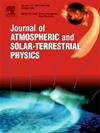宇宙射线和太阳黑子时间序列的多重分形去趋势互相关系数
IF 1.8
4区 地球科学
Q3 GEOCHEMISTRY & GEOPHYSICS
Journal of Atmospheric and Solar-Terrestrial Physics
Pub Date : 2025-01-01
DOI:10.1016/j.jastp.2024.106407
引用次数: 0
摘要
本研究深入研究了宇宙射线强度与太阳黑子数之间的多重分形相互关联,解决了传统相关分析往往无法捕捉这些时间序列的复杂性和多重分形性质的缺点。宇宙射线和太阳活动是空间天气动力学的关键组成部分,了解它们之间的相互作用对于预测可能影响卫星运行、通信系统甚至地球气候的空间天气事件至关重要。我们采用多重分形去趋势互相关分析(MFDCCA)来探索这些复杂的关系,跨越时间尺度的范围。我们的方法包括将时间序列分割为不同长度的窗口(从50天到3900天),并使用多项式阶数2,3,4和5计算不同多项式拟合阶数和波动阶数q=[0.5,1,2,3,4,5]的相互关联系数。这种方法允许我们捕捉多重分形特性和序列内部和序列之间的时间依赖性。我们的分析显示了显著的多重分形相关性,在q=0.5和多项式阶数为2的情况下,相关系数最高,为0.876,滞后57天。结果表明,多项式阶越高,系数越稳定,鲁棒性越强,在更大的尺度上相关性越强。这些发现突出了像MFDCCA这样的先进技术在揭示宇宙射线和太阳活动之间复杂的相互作用方面的功效,这是传统方法经常忽略的。我们的研究的意义延伸到空间天气预报模型的增强。通过结合额外的太阳物理变量,如太阳风条件、行星际磁场数据以及日冕物质抛射或太阳耀斑指数,未来的研究可以构建更全面的模型,更好地捕捉控制这些现象的多重分形相互作用。这种扩大的认识对于提高空间天气预报的准确性和减轻空间天气事件对技术和自然系统的潜在影响至关重要。本文章由计算机程序翻译,如有差异,请以英文原文为准。
Multifractal detrended cross-correlation coefficient for cosmic ray and sunspot time series
This study delves into the multifractal cross-correlations between cosmic ray intensity and sunspot numbers, addressing the shortcomings of traditional correlation analyses that often fail to capture the intricate and multifractal nature of these time series. Cosmic rays and solar activity are critical components of space weather dynamics, and understanding their interactions is essential for predicting space weather events that can affect satellite operations, communication systems, and even climate on Earth. We employ Multifractal Detrended Cross-Correlation Analysis (MFDCCA) to explore these complex relationships across a range of time scales. Our methodology involves segmenting the time series into windows of varying lengths, from 50 to 3900 days, and calculating cross-correlation coefficients for different polynomial fitting orders and fluctuation orders , using polynomial orders of 2, 3, 4, and 5. This approach allows us to capture the multifractal properties and temporal dependencies within and between the series.
Our analysis reveals significant multifractal correlations, with the highest correlation coefficient of 0.876 occurring for and polynomial order 2 with a lag of 57 days. The results demonstrate that higher polynomial orders result in more stable and robust coefficients, indicating stronger correlations on larger scales. These findings highlight the efficacy of advanced techniques like MFDCCA in uncovering the complex interactions between cosmic rays and solar activity, which are often missed by conventional methods. The implications of our study extend to the enhancement of space weather prediction models. By incorporating additional heliophysical variables such as solar wind conditions, interplanetary magnetic field data, and indices of coronal mass ejections or solar flares, future research can construct more comprehensive models that better capture the multifractal interactions governing these phenomena. This expanded understanding is crucial for improving the accuracy of space weather forecasts and mitigating the potential impacts of space weather events on technological and natural systems.
求助全文
通过发布文献求助,成功后即可免费获取论文全文。
去求助
来源期刊

Journal of Atmospheric and Solar-Terrestrial Physics
地学-地球化学与地球物理
CiteScore
4.10
自引率
5.30%
发文量
95
审稿时长
6 months
期刊介绍:
The Journal of Atmospheric and Solar-Terrestrial Physics (JASTP) is an international journal concerned with the inter-disciplinary science of the Earth''s atmospheric and space environment, especially the highly varied and highly variable physical phenomena that occur in this natural laboratory and the processes that couple them.
The journal covers the physical processes operating in the troposphere, stratosphere, mesosphere, thermosphere, ionosphere, magnetosphere, the Sun, interplanetary medium, and heliosphere. Phenomena occurring in other "spheres", solar influences on climate, and supporting laboratory measurements are also considered. The journal deals especially with the coupling between the different regions.
Solar flares, coronal mass ejections, and other energetic events on the Sun create interesting and important perturbations in the near-Earth space environment. The physics of such "space weather" is central to the Journal of Atmospheric and Solar-Terrestrial Physics and the journal welcomes papers that lead in the direction of a predictive understanding of the coupled system. Regarding the upper atmosphere, the subjects of aeronomy, geomagnetism and geoelectricity, auroral phenomena, radio wave propagation, and plasma instabilities, are examples within the broad field of solar-terrestrial physics which emphasise the energy exchange between the solar wind, the magnetospheric and ionospheric plasmas, and the neutral gas. In the lower atmosphere, topics covered range from mesoscale to global scale dynamics, to atmospheric electricity, lightning and its effects, and to anthropogenic changes.
 求助内容:
求助内容: 应助结果提醒方式:
应助结果提醒方式:


